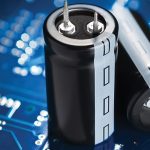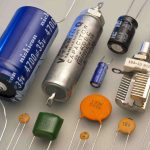There are different types of capacitors available in the market. The key factor in distinguishing different types of capacitors is the Dielectric used in its construction. Some of the common capacitor types are ceramic, electrolytic (which include Aluminium capacitors, Tantalum capacitors and Niobium capacitors), plastic film, paper and mica.
Each capacitor type has its own advantages and disadvantages. The characteristics and areas of applications may vary from one capacitor to other. Hence, when choosing a capacitor, following few of many factors must be considered.
Size: Both the physical dimension and the value of the capacitance is important.
Working Voltage: It is an important characteristic of the capacitor. It specifies the maximum voltage that can be applied across the capacitor.
Leakage Current: A small amount of current will flow through dielectric as they are not the perfect insulators. This is called leakage current.
Equivalent series resistance: The terminals of the capacitor have a small amount of resistance (usually less than 0.1Ω). This resistance becomes a problem when the capacitor used at high frequencies.
These factors determine how and in what applications a particular type of capacitor can be used. For example, the rated voltage of an electrolytic capacitor is larger when compared to a ceramic capacitor in the similar capacitance range.
So they are generally used in power supply circuits. Similarly, some capacitors have very low leakage current and others have very high leakage current. Depending on the application, appropriate capacitor should be chosen

Dielectrics in Capacitors
Fixed capacitors are more common types of capacitors. It is difficult to find an electronic circuit without a capacitor. Most of the capacitors are named after the dielectric used in the construction. Some of the common dielectrics used in the construction of capacitors are:
· Ceramic
· Paper
· Plastic film
· Mica
· Glass
· Aluminium Oxide
· Tantalum Pentoxide
· Niobium Pentoxide
The last three are used in electrolytic capacitors. Despite the use of different kinds of dielectrics in the construction of capacitors, the functionality of the capacitor doesn’t change: to store energy in the form of electric charge between the parallel plates.
Variable Capacitors
Like resistors, capacitors are also available as fixed and variable types. Variable capacitors are those in which the capacitance can be changed either mechanically or electronically. Such capacitors are generally used in resonant circuits (LC circuits) for tuning radios and impedance matching in antennas. These capacitors are usually called Tuning Capacitors.
Ceramic Capacitors
Ceramic capacitors are the most used capacitors in the electronics industry. They are also the most produced capacitors with over 1000 billion units being produced every year. The name comes from the ceramic material which is the dielectric used in its construction.
Film Capacitor
Film capacitors are the most commonly used type of capacitors among all types of capacitors which have the difference in their dielectric properties.Film capacitors are the capacitors with an insulating plastic film as its dielectric and these are non-polarised capacitors.
The dielectric materials for these capacitors are existed in the form of a thin layer which is provided with metallic electrodes and it is wounded in to a cylindrical winding. The both electrodes of film capacitors may be zinc or metalized aluminium.
Film power capacitors
Film power capacitors are also called as Power film capacitors.The construction techniques and materials which are used for large power film capacitors are usually similar to those of the ordinary film capacitors. However these capacitors with high power ratings are used in the applications of power systems and electrical installations.
Power film capacitors are used in variety of applications. These capacitors serve as snubbing or damping capacitors when connected a resistor in series with it. These are also used in close tuned or low detuned filter circuits for filtering the harmonics and also used as pulse discharge capacitors.
Ceramic Capacitors
Ceramic capacitors are also called as “Disc-capacitors”. Like electrolytic, these are also the mostly used type of capacitors. A ceramic capacitor is constructed with two or more alternating layers of ceramic and a metal.Here the ceramic acts as its dielectric and metal acts as its electrodes. These ceramic capacitors are non-polarised fixed type capacitors. Generally the electrical behavior of the ceramic material can be divided into two classes related to its stability.
Polypropylene Capacitor
Polypropylene capacitor is one of the many varieties of film type capacitors. Polypropylene capacitors are the capacitors that have a polypropylene film as their dielectric. Polypropylene capacitors are available within the capacitance ranges from 100 pf to 10µF.
The main feature of Polypropylene Capacitor is high working voltages up to 3000 V. This feature makes polypropylene (pp) capacitors useful in circuits in which operating voltages are typically very high, such as power amplifiers particularly valve amplifiers, power supply circuits and TV circuits.
Polycarbonate capacitor
Polycarbonate capacitors are the capacitors that have a polycarbonate material as its dielectric. These types of capacitors are available within the capacitance range of 100pF to 10µF and have the working voltages up to 400V DC. These polycarbonate capacitors can operate with a temperature range of -55°C to +125°C without de-rating.
Silver Mica Capacitor
Silver Mica Capacitors are capacitors that are made from depositing a thin layer of silver on a mica material as its dielectric.The reason for the use of silver mica capacitors is that their high performances compared to any other type of capacitors.
Silver mica capacitors can be obtained with the tolerance of +/- 1%. This is much better than any other type of capacitor which is available in today’s market. The temperature co-efficient of silver mica capacitors is much better than other types of capacitors.
Electrolytic Capacitors
Electrolytic Capacitors are generally used in the applications where very large capacitance values are required. The electrolytic capacitors have a metallic anode covered with an oxidized layer generally used as its dielectric. Another electrode of a capacitor is a non-solid or solid electrolyte.


